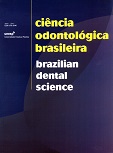Effect of refrigeration of resin materials on the occurrence of microleakage in class II restorations
DOI:
https://doi.org/10.14295/bds.2007.v10i4.263Abstract
Many professionals currently store their restorative materials in refrigerators, even though the manufacturers do not recommend this. This study evaluated the microleakage occurring in Class II restorations performed with composite resin stored at different conditions and temperatures. Thirty intact human molars were employed, which received vertical slot cavity preparations with the following dimensions: 3mm in buccolingual direction, 1.5mm in mesiodistal direction, and 5mm in cervico-occlusal direction (at 1mm short of the cemento-enamel junction). Specimens were restored with the adhesive material Prime & Bond NT and composite resin TPH Spectrum (Dentsply) with 3 different conditions: G-I application of restorative materials at room temperature (nearly 25oC), G-II application of restorative materials 30 minutes after removal from the refrigerator (25oC), and G-III application of restorative materials immediately after removal from the refrigerator (6oC). The specimens were sealed and immersed in 2% buffered methylene blue aqueous solution at 37oC, for 4 hours. Thereafter, the specimens were sectioned and evaluated as to the degree of marginal leakage at the dentin-cementum/restoration interface and also as to the type of dye leakage observed. Data achieved were submitted to statistical analysis by the non-parametric method Kruskal-Wallis (p<0.05) for comparison of the degree of leakage, and ratio test for comparison of differences in the pattern of leakage. No adverse effects were observed on the occurrence and pattern of microleakage when the restorative system was employed immediately after or 30 minutes after storage in the refrigerator, or at room temperature.Downloads
Downloads
Published
How to Cite
Issue
Section
License
Brazilian Dental Science uses the Creative Commons (CC-BY 4.0) license, thus preserving the integrity of articles in an open access environment. The journal allows the author to retain publishing rights without restrictions.
=================




























